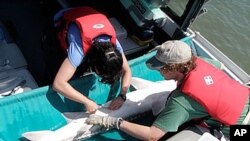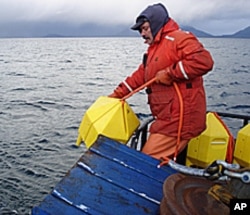A unique array of underwater listening devices stretches 3,000 kilometers along the west coast of North America to track marine life along the continental shelf.
"It's like giving fish a cell phone," says Pacific Ocean Shelf Tracking (POST) executive director Jim Bolger, whose network is part of a global project called the Census of Marine Life, an on-going effort to assess the diversity and abundance of life in the world's oceans.
Tiny transmitters
POST has strategically placed over 450 hydrophones on the sea floor.
Fish tagged with tiny transmitters emit a special signal when they pass by one of the hydrophone receivers. Rows of these small receivers form listening lines perpendicular to the shore, at intervals of about 800 meters. Bolger says the lines, which can run 50 kilometers in length, create a grid that captures fish movement across the ocean never before available.
"If an animal passes through one line, we hear it, and if it passes through the next line we know it's continuing and which direction it's moving in and about how fast. If it doesn't show up at the next line of receivers, either it's taken up residency in between or maybe it's died."
Over the last six years POST has followed some 16,000 tagged marine animals, including 18 different species from salmon the size of a hotdog to great white sharks.
Bolger says a couple of times each year, POST collects the underwater data from each acoustic receiver and relays it to a ship on the surface.
Better protection for endangered species
POST recently published the first in a series of studies from its telemetry data with some unexpected findings. The endangered California sturgeon, for example, was tracked migrating north over vast distances in the winter, giving wildlife managers clues to better protect it.
Other research challenges the theory that more salmon die in dammed waterways than wild rivers. The paper compares the salmon life cycle in the heavily dammed Columbia River with that of the Fraser River in Southern British Columbia that has no dams. Bolger says the POST data showed that the survival was the same in both groups.
"And so, what does that really mean? I think the jury is still out on that. But the fact that there is comparable survival really makes you wonder as to what are the factors that are affecting the health of these populations in both major rivers."
Bolger says the POST array can serve as a baseline for movement of various species as ocean conditions change over time in response to climate change. "We can start to really see how the animals that live in these oceans are adapting to climate changes or not adapting. And we can do a better job of sustaining the life that is here."
All POST data and research derived from that data become part of the public record and are available for free online. Bolger says the project opens a new window on the sea and invites anyone interested in exploring the view to support the project by purchasing a radio tag and following a tagged fish on the POST Census of Marine Life website.



















